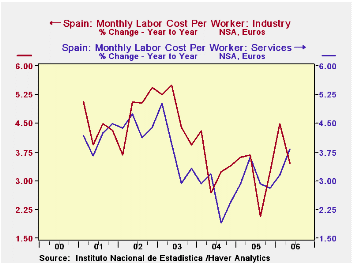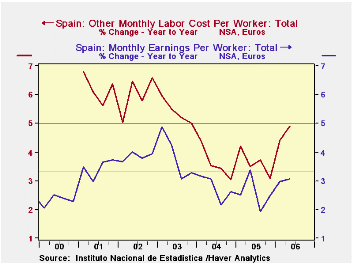 Global| Sep 20 2006
Global| Sep 20 2006Spain's Labor Costs Pick Up in Q2; Benefits Outstrip Wage Gains
Summary
Spain's National Institute of Statistics (INE) reported on labor costs today for Q2 2006. These costs, measured as monthly compensation per worker, picked up to a 3.5% growth rate year-on-year from 3.4% in Q1 and at or near 3.0% for [...]

Spain's National Institute of Statistics (INE) reported on labor costs today for Q2 2006. These costs, measured as monthly compensation per worker, picked up to a 3.5% growth rate year-on-year from 3.4% in Q1 and at or near 3.0% for the previous two calendar years. The data are in a simple format: in Haver's SPAIN database, they are available in euros and an index of 2000=100, for three sectors of the economy, industry, construction and services, and for the total and two components, earnings and "other". So there are 12 numbers in each quarterly report for each the euro amount and the index level. Could such a small array be interesting? Indeed.
In Q2, while labor costs accelerated in total, they slowed in basic industry and construction and not by small increments. The industry sector increased 3.5% following 4.5% in Q1. Construction gained 3.9% in the latest quarter, after 4.3% in Q1. But the rapidly expanding service sector had 3.8% growth in Q2, well more than the 3.2% in Q1. So labor compensation in services gained visibly even as it slowed in more traditional sectors. However, this may have been a transitory shift, as the average annual gains over the prior five years had the reverse pattern: industry and construction both had vigorous increases, 4.1% annually for industry and 4.7% for construction, with services at 3.6%. So it's hard to tell if the old-line economy is moving to a slower trend or just pausing after sizable gains in earlier periods. In fact, if anything, these data show how consistent the service sector has been, hovering all the while in a range around 3-1/2% average yearly gains.
Another significant point in this little array of data concerns the split between wages and "other" labor costs. Over the period 2000-2005, earnings grew at an average annual rate of 3.3%. But other labor compensation advanced at a 5.0% pace. These costs cover the same general items referred to in the US as "supplements to wages and salaries" or "benefits": disability and unemployment, and also in Spain compensation for tools, uniforms and transportation, and similar job-related expenses. In both countries, these also cover employers' payments into the social security system. And in Spain as in the US, to continue the parallel, these "other" costs are growing as a portion of total compensation: in 2000, "other" labor costs were 24.6% of compensation in Spain and by the first half of this year, they absorbed 26.7%. For the US, comparable shares were 16.5% in 2000 and 19.3% this year.
| Spain: Monthly Labor Cost/ Worker (€, NSA) | Q2 2006 | Q1 2006 | Q2 2005 | 2005 | 2004 | 2003 | 2000 |
|---|---|---|---|---|---|---|---|
| Total | 2197 | 2114 | 2122 | 2110 | 2058 | 1992 | 1758 |
| Yr/Yr % Chg | 3.5 | 3.4 | 3.4 | 2.9 | 3.0 | 4.2 | 3.7 |
| Earnings | 1624 | 1538 | 1575 | 1560 | 1521 | 1480 | 1326 |
| Yr/Yr % Chg | 3.1 | 3.0 | 3.4 | 2.6 | 2.8 | 3.8 | 3.3 |
| "Other" | 574 | 575 | 547 | 550 | 531 | 512 | 432 |
| Yr/Yr % Chg | 4.9 | 4.4 | 3.5 | 3.6 | 3.6 | 5.4 | 5.0 |
| "Other" as % of Total | 26.1 | 27.2 | 25.8 | 26.1 | 25.9 | 25.7 | 24.6 |
| Memo: Similar US Share | 19.3 | 19.3 | 19.4 | 19.4 | 19.1 | 19.0 | 16.5 |
Carol Stone, CBE
AuthorMore in Author Profile »Carol Stone, CBE came to Haver Analytics in 2003 following more than 35 years as a financial market economist at major Wall Street financial institutions, most especially Merrill Lynch and Nomura Securities. She had broad experience in analysis and forecasting of flow-of-funds accounts, the federal budget and Federal Reserve operations. At Nomura Securities, among other duties, she developed various indicator forecasting tools and edited a daily global publication produced in London and New York for readers in Tokyo. At Haver Analytics, Carol was a member of the Research Department, aiding database managers with research and documentation efforts, as well as posting commentary on select economic reports. In addition, she conducted Ways-of-the-World, a blog on economic issues for an Episcopal-Church-affiliated website, The Geranium Farm. During her career, Carol served as an officer of the Money Marketeers and the Downtown Economists Club. She had a PhD from NYU's Stern School of Business. She lived in Brooklyn, New York, and had a weekend home on Long Island.





